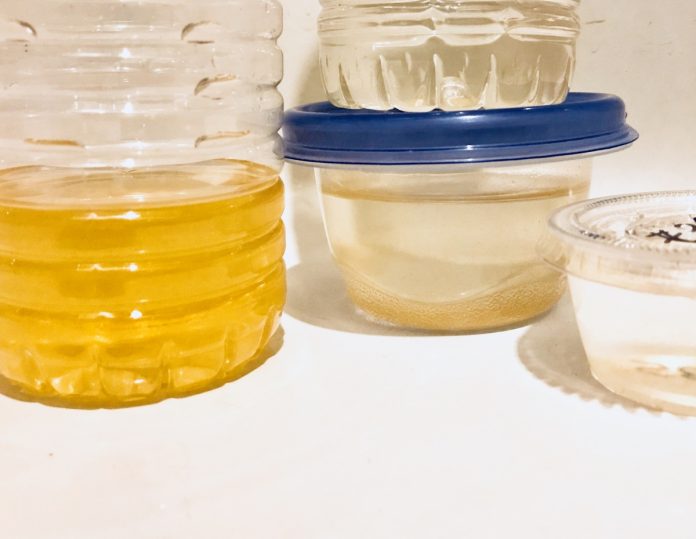
To assist residents with understanding with discoloration of water in some parts of South Pasadena, the city officials have developed a comprehensive FAQ. This FAQ will be updated as more information becomes available.
The Public Works Department is addressing reports of cloudy and discolored water in some homes across certain areas of the City. In addition to working directly with customer experiencing issues, the City is working closely with the State and water experts to implement near- and long-term solutions to address the problem. Ongoing tests demonstrate South Pasadena drinking water is safe and meets United States Environmental Protection Agency (USEPA) and State Water Resources Control Board, Division of Drinking Water (DDW) standards.
In March, the City switched from its usual groundwater supply to surface water purchased from the Metropolitan Water District (MWD). This is a temporary solution to address the requirement for the City to discontinue use of most of its groundwater supply until treatment is in place to meet a new State regulation. The City has used MWD water previously with no discolored water issues. However, it appears that extended, ongoing usage of MWD water maybe causing release of iron from some pipes.
Finding a solution for the discolored water is the City’s top priority. The City has identified near-term solutions to address the discoloration caused by the MWD water supply, and next steps to provide temporary, and then permanent wellhead treatment so that we can return to our groundwater supply as quickly and efficiently as possible.
The City is providing free, in-home testing for residents experiencing discoloration issues on request. It is important to note that all samples collected from drinking water faucets or bathroom sinks in these homes have been well within State and Federal limits for lead, manganese, and arsenic.
Information about tap water and results of water quality tests will be uploaded to southpasadenaca.gov. In addition, the City prepares an annual “Consumer Confidence Report” which can be found on the city website. The 2017 Consumer Confidence Report will be published in July.
Discolored or cloudy water can be reported to the Public Works Department, Water Division, at (626) 403-7240.
Q&A provided by the City of South Pasadena
1. IS OUR TAP WATER SAFE?
To date, ongoing tests of the City’s water supply demonstrate it meets Federal and State drinking water quality requirements. Results of samples collected from drinking faucets and bathroom sinks show water is well within State and Federal limits for lead, manganese, and arsenic. We continue to collect additional samples and data to ensure the water remains safe. These test results are also provided to the State for review.
If you are experiencing discolored water, please contact the City’s Public Works Department, Water Division, at (626) 403-7240. We also recommend you try running water on cold from taps until the water is clear. If you would like your tap water tested, the City has contracted independent, certified laboratories to analyze the collected samples, with the results are provided back to residents promptly.
2. WHAT IS THE BROWN-ISH COLOR?
Testing from the City’s mains and from residents’ faucets demonstrate the yellow and brown discoloration is caused by elevated iron levels. When water stagnates in galvanized pipes (for example from taps not being used overnight), iron can dissolve into the water and result in discoloration. While aesthetically unappealing, according to the U.S. Environmental Protection Agency (EPA), the level of iron in the discolored water some residents are experiencing is not harmful to your health. Even so, the City fully acknowledges that discolored water is not acceptable, and we are working to address the issue.
3. HOW WIDESPREAD IS THE PROBLEM?
The effects are predominately observed in dwellings with older, galvanized iron piping located near dead- end water mains. So far, out of the City’s 6,200 water customers, fewer than 100 (residential) customers have reported discolored water and/or requested testing. While this represents fewer than two percent of the City’s water customers, it is not acceptable to the City and we are doing everything we can, and as quickly as we can, to eliminate the problem.
4. WHAT SHOULD I DO IF MY WATER IS DISCOLORED?
We encourage all residents who are experiencing discolored water to contact the City’s Public Works Department, Water Division, at (626) 403-7240. Public Works staff are dispatched to assist the resident and take samples of the water.
5. IS THERE ANYTHING I CAN DO AT HOME?
Most residents experiencing this issue should be able to clear the discoloration by running their faucet on cold for under a minute. The City can supply you with a bucket to collect and reuse water, which is safe for plants.
Faucet aerators can trap ‘corrosion scales’, which can also add color to water. It is advisable to remove and clean faucet aerators regularly. Customers may also consider flushing water heaters annually to remove any material that precipitated in the heater over time.
6. WHAT DOES THE LAB TEST FOR?
Currently, in addition to our ongoing water testing throughout the South Pasadena water system, we are taking in-home samples, on request, and testing for lead and arsenic which are considered “primary” contaminants, as well as iron and manganese, which are “secondary” regulated contaminants. Primary standards address health concerns at specified levels; Secondary standards address aesthetic concerns (i.e. color, odor and taste), including those associated with iron. Lab results are provided to residents and City staff are available on request to assist with explaining the results.
A full list of State Primary MCLs is available here:
https://www.waterboards.ca.gov/drinking_water/certlic/drinkingwater/documents/ccr/ MCLsEPAvsDWP-2018-03-21.pdf
A full list of State Secondary MCLs is available here:
https://www.waterboards.ca.gov/drinking_water/certlic/drinkingwater/documents/ recentlyadoptedregulations/R-21-03-finalregtext.pdf
7. WHY IS THIS HAPPENING?
In March, the City switched from its usual groundwater supply to surface water purchased from the Metropolitan Water District (MWD). This is a temporary solution to address the requirement for the City to discontinue use of most of its groundwater supply until treatment is in place to meet a new State regulation. The City has used MWD water previously with no discolored water issues. However, it appears that extended, ongoing exposure to MWD water maybe causing release of iron from some pipes.
Every community water supply and distribution system is unique. South Pasadena’s system ordinarily relies on groundwater, which is treated with chlorine for disinfection, but MWD’s surface water is treated with chloramine. While both are common water disinfectants, they have difference chemical properties and can react differently with pipes and fixtures, particularly older galvanized iron pipes. We suspect that as MWD’s chloramine-treated water stays in some older pipes for a prolonged period, it may release some of the iron from the pipe and turn the water yellow or brown. Once this water is flushed through the pipes, water from the main system enters the home and water runs clear.
8. WHAT IS BEING DONE ABOUT THE DISCOLORED WATER?
Finding a solution for the discolored water is the City’s top priority. The City has identified near-term solutions to address the discoloration caused by the MWD water supply, and next steps to provide temporary, and then permanent wellhead treatment so that we can return to our groundwater supply as quickly and efficiently as possible.
A. Near-Term: Breakpoint Chlorination
Removing the chloramine in MWD’s water through adding chlorine as the water enters the City’s system. This is achieved with a process called ‘breakpoint chlorination’. It involves adding chlorine to the water to destroy the chloramine and produce water with chlorine as the only disinfectant. This will create the same conditions using chlorine that our City and in-home pipes are accustomed to, which we hope will eliminate the effects of the chloramine on the pipes and stop the release
of iron into the water. This solution was recommended by an independent water quality consultant who identified the switch from chlorine to chloramine in MWD water as the most likely cause of the discoloration.
This approach will require the City to set up a chlorine injection system at MWD’s water connection point to the South Pasadena water system and install several monitoring instruments to ensure
the system is operating reliably. It will also require pre-approval of the State’s Division of Drinking Water before it can be implemented. With these in mind, we are hopeful that this system could be in operation by early July.
B. Mid-Term:TemporaryWellheadTreatment
This temporary system would treat the City’s existing groundwater, reducing 1,2,3-TCP levels to below State Maximum Contaminant Levels. City staff are working with the State to determine if such a system is permitted and are identifying the costs of installation and operation.
This solution would allow the City to resume using its previous water source, which would mean MWD’s supply is no longer needed. More information on this will be available in late June.
C. Long-Term: Granular Activated Carbon Wellhead Treatment System
The permanent solution to comply with the new 1,2,3-TCP regulation is to install a Granular Activated Carbon (GAC) wellhead treatment system at the Wilson Reservoir. This is a specialized treatment system that has a long lead time as it needs to be specifically designed to suit South Pasadena’s water treatment requirements. The contract award for the wellhead treatment system is being considered by the City Council at the June 6, 2018 City Council Meeting.
This solution allows the City to resume using its previous water source, which would mean MWD’s supply is no longer needed. It is anticipated this will be operational by January 2019.
9. WHAT IS THE CITY DOING RIGHT NOW?
In addition to the temporary and long-term solutions outlined above, the City is also:
1. Responding promptly to all discoloration complaints and queries.
2. Conducting water quality tests in affected residences to ensure water is disinfected adequately and is safe to drink.
3. Flushing the public water system in areas of low water use, where water may stagnate.
4. Replacing City-owned galvanized service laterals with copper.
10. WHY DID SOUTH PASADENA SWITCH FROM GROUNDWATER TO METROPOLITAN
WATER DISTRICT WATER?
Based on new state regulations enacted in late 2017, the City must install additional treatment facilities for our groundwater supplies. Since November 2017, the City has been designing and working toward procurement of the treatment facilities. While this is underway, and to ensure compliance with these
new regulations, the City has increased use of Metropolitan Water District (MWD) surface water. We have used our valuable MWD backup supply on many occasions, with no discolored water issues, so we had no reason to expect a problem.
The State regulation is for 1,2,3-Trichloropropane (TCP), an industrial solvent no longer used but found
in groundwater throughout the State. The new wellhead treatment facilities, which are scheduled to be online by January 2019, will bring the 1,2,3-TCP levels to within regulatory standards allowing us to return to our mostly groundwater supply.
11. WHEN CAN SOUTH PASADENA RETURN TO ITS GROUNDWATER SUPPLY?
The City is currently in the process of designing and installing a granular activated carbon (GAC) wellhead treatment system at Wilson Reservoir. Once treatment meets the new regulatory standard for 1,2,3-TCP (five parts per trillion), the State will approve the system and allow full return to groundwater supplies. The wellhead treatment facility is expected to be completed and in use by January 2019, although the City is also investigating if a temporary treatment system is feasible. The City is actively working to expedite procurement and installation.
June 4, 2018 Page 3
12. WHY DIDN’T YOU HAVE THE WELLHEAD TREATMENT IN PLACE ALREADY?
While the State had been talking about the possibility of setting a new regulation for 1,2,3-TCP, it was not clear where the limit would be set, and therefore, we would not have been able to determine the need
or design for treatment until the limit was set. Unfortunately, the State gave only three months to meet the standard, which is impossible to do when a treatment system needs to be designed and built. From extensive previous experience using MWD’s surface water, there was no reason to anticipate any issues associated with tap water discoloration. Using MWD’s surface water was a demonstrated, State-approved and proactive solution.
13. WHAT IF FAUCET FLUSHING DOESN’T WORK AT MY HOUSE?
We have visited many homes and found success through faucet flushing. Unfortunately, flushing from faucets may need to be repeated while we continue to rely on MWD water. If flushing is not working for you, please call us at (626) 403-7240.
14. WHERE CAN I ACCESS INFORMATION ABOUT WHAT IS IN OUR TAP WATER?
Those who have had water tested within their homes will receive specific results for their home. It is important to note that of the many homes tested so far, all samples collected from drinking water faucets or bathroom sinks have been well within State and Federal limits for lead, manganese, and arsenic.
Information about tap water and results of water quality tests will be uploaded monthly to southpasadenaca.gov. In addition, the City prepares an annual “Consumer Confidence Report” which can be found on our website. The 2017 Consumer Confidence Report will be published in July.
15. MY WATER HAS AN ODOR. WHY IS THAT?
If you are experiencing this issue, please let us know by calling (626) 403-7240. For some people, higher levels of iron in water may have a rust or sulfurous odor. Issues with odors can also be associated with lack of venting or p-traps (the “u” shaped pipe installed under sinks) not being installed on drain pipes. This can occur near kitchen sinks, showers, bathtubs or any drains connected to the sewer line. Running water briefly from the tap can also address this issue.
Information provided by the City of South Pasadena


















.png)










